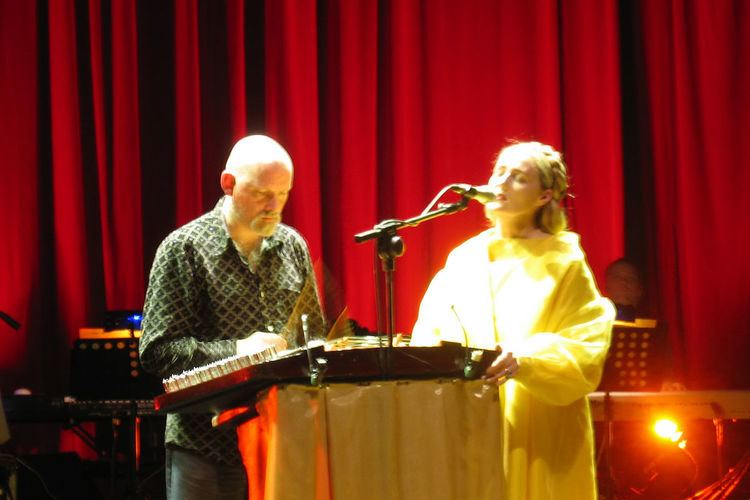 | ||
Stylistic origins New wavepost-punkgothic rockpost-industrialsynthpop Cultural origins Late 1970s to early 1980s in Europe (most notably United Kingdom, Germany, France and Italy) and Australia | ||
Dark wave or darkwave is a musical term used for dark, usually gothic rock-influenced music that incorporates synthesizers, or elements of new wave and synthpop, although the term is also applied to post-punk bands that produce a dark atmosphere. The label began to appear in the late 1970s in German music media, coinciding with the popularity of new wave and post-punk. Building on those basic principles, dark wave is used to describe dark, introspective lyrics and an undertone of sorrow for some bands. In the 1980s, a subculture developed primarily in Europe alongside dark wave music, whose members were called "wavers" or "dark wavers".
Contents
1980s
The term was coined in Germany in the 1980s to describe a dark and melancholy variant of new wave and post-punk music, such as gothic rock and synthwave (i.e. electronic new wave music), and was first applied to musicians such as Bauhaus, Joy Division, The Sisters of Mercy, Tears for Fears, Cocteau Twins, The Cure, Siouxsie and the Banshees, The Chameleons, Depeche Mode, Gary Numan, and Anne Clark.
The movement spread internationally, spawning such developments as French coldwave. Coldwave described groups such as KaS Product, Martin Dupont, Asylum Party, Norma Loy, Pavillon 7B, Résistance, Clair Obscur, Opera Multi Steel, Museum of Devotion, The Breath of Life, and Trisomie 21. Subsequently, different dark wave genres merged and influenced each other, e.g. synthwave (also referred to as "electro-wave" in Germany) with gothic rock, or used elements of post-industrial music. Attrition, In The Nursery, Party Day and Pink Industry (UK), Clan of Xymox (Netherlands), Mittageisen (Switzerland), Parálisis Permanente and Los Monaguillosh (Spain), Die Form (France), and Psyche (Canada) played this music in the 1980s. German dark wave groups of the 1980s were associated with the Neue Deutsche Welle, and included Asmodi Bizarr, II. Invasion, Unlimited Systems, Mask For, Moloko †, Maerchenbraut and Xmal Deutschland. In the United States, Eleven Pond were the most prominent darkwave act, releasing just one album, Bas Relief, in 1986.
1990s
After the new wave and post-punk movements faded in the mid-1980s, dark wave was renewed as an underground movement by German bands such as Girls Under Glass, Deine Lakaien, Love Is Colder Than Death, early Love Like Blood, and Diary of Dreams, as well as Project Pitchfork along with its offshoot Aurora Sutra, and Wolfsheim. The Italians The Frozen Autumn, Kirlian Camera, Ataraxia, and Nadezhda, the South African band The Awakening and the French Corpus Delicti, also practiced the style. All of these bands followed a path based on the new wave and post-punk movements of the 1980s. At the same time, a number of German artists, including Das Ich, Relatives Menschsein and Lacrimosa, developed a more theatrical style, interspersed with German poetic and metaphorical lyrics, called Neue Deutsche Todeskunst (New German Death Art). Other bands such as Silke Bischoff, In My Rosary, and Engelsstaub mingled synthwave or goth rock with elements of the neofolk or neoclassical genres.
After 1993, in the United States the term dark wave (as the one-word variant 'darkwave') became associated with the Projekt Records label, because it was the name of their printed catalog, and was used to market German artists like Project Pitchfork. In the U.S. Projekt features bands such as Lycia, Black Tape for a Blue Girl and Love Spirals Downwards, most of these characterized by female vocals. This style took cues from 1980s bands like Cocteau Twins. The label has also had a long association with Attrition, who appeared on the label's earliest compilations. Another American label in this vein was Tess Records, which featured This Ascension and Faith and the Muse. Clan of Xymox, who had returned to their 1980s sound, following almost a decade as the more dance-pop Xymox, also signed to Tess in 1997.
Joshua Gunn, a professor of communication studies at Louisiana University, described the U.S. type of dark wave music as
The 2000s and "wave"-divergence
In the late 1990s and early 2000s, many artists in the genre displayed wave-atypical influences, especially electronic dance and downtempo music. Acts such as Love Spirals Downwards, Collide, Deleyaman and Switchblade Symphony incorporated trip hop and drum & bass rhythms. Abney Park (which began as a dark wave/goth rock band), synthesized worldbeat elements and gravitated to a more exotic/anachronistic sound, underpinning their evolving steampunk trajectory. Bella Morte (whose initial dark wave output was more akin to electropop), incorporated deathrock/heavy metal elements, while Faith & The Muse combined dark wave with shoegazing.
Meanwhile, The Crüxshadows, who had begun in the 1990s as a synthrock-oriented dark new wave group, added elements of techno/trance and dance pop to their electronic rock-oriented music. Throughout the mid/late-2000s, especially in the U.S., the term 'dark wave' was frequently associated with the band and their Dancing Ferret labelmates (1998–2009), including ThouShaltNot, Ego Likeness and The Last Dance.
Darkwave in the 2010s
More recent darkwave acts have included dark electronic artists such as Cold Cave and TR/ST, who, while not actively associated with earlier darkwave artists, actively combine electronic music with dark aesthetics and themes. Others, such as Seeming (fronted by ThouShaltNot's Alex Reed), represent a direct evolution and continuation of earlier trends in darkwave music. Additionally, the decade also saw a revival of an early, post-punk infused dark wave sound embodied by artists such as Light Asylum, She Past Away, Lebanon Hanover, Ash Code and Drab Majesty.
